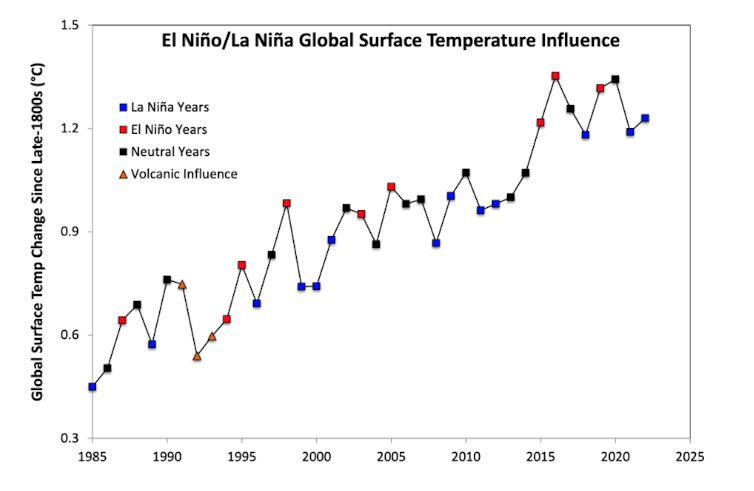In the past few weeks, climate records have shattered across the globe – 4 July was the hottest global average day on record, breaking the record set the previous day. Average sea surface temperatures have been the highest ever recorded and Antarctic sea ice extent the lowest on record.


Also on 4 July, the World Meteorological Organisation declared El Niño had begun, “setting the stage for a likely surge in global temperatures and disruptive weather and climate patterns”.
So what’s going on with the climate, and why are we seeing all these records tumbling at once?
Against the backdrop of global warming, El Niño conditions have an additive effect, pushing temperatures to record highs. This has combined with a reduction in aerosols, which are small particles that can deflect incoming solar radiation. So these two factors are most likely to blame for the record-breaking heat, in the atmosphere and in the oceans.
Read more: Ocean heat is off the charts – here’s what that means for humans and ecosystems around the world
It’s not just climate change
The extreme warming we’re witnessing is in large part due to the El Niño now occurring, which comes on top of the warming trend caused by humans emitting greenhouse gases.


El Niño is declared when the sea surface temperature in large parts of the tropical Pacific Ocean warms significantly. These warmer-than-average temperatures at the surface of the ocean contribute to above-average temperatures over land.
The last strong El Niño was in 2016, but we’ve released 240 billion tonnes of CO₂ into the atmosphere since then.
El Niño doesn’t create extra heat, but redistributes the existing heat from the ocean to the atmosphere.
The ocean is massive. Water covers 70% of the planet and is able to store vast amounts of heat due to its high specific heat capacity. This is why your hot water bottle stays warm longer than your wheat pack. And, why 90% of the excess heat from global warming has been absorbed by the ocean.
Ocean currents circulate heat between the Earth’s surface, where we live, and the deep ocean. During an El Niño, the trade winds over the Pacific Ocean weaken, and the upwelling of cold water along the Pacific coast of South America is reduced. This leads to warming of the upper layers of the ocean.
Higher-than-usual ocean temperatures along the equator were recorded in the first 400m of the Pacific Ocean throughout June 2023. Since cold water is more dense than warm water, this layer of warm water prevents colder ocean waters from penetrating to the surface.
Warm ocean waters over the Pacific also lead to increased thunderstorms, which further release more heat into the atmosphere via a process called latent heating.


This means that the buildup of heat from global warming that had been hiding in the ocean during the past La Niña years is now rising to the surface and demolishing records in its wake.
An absence of aerosols across the Atlantic
Another factor likely contributing to the unusual warmth is a reduction in aerosols.
Aerosols are small particles that can deflect incoming solar radiation. Pumping aerosols into the stratosphere is one of the potential geoengineering methods that humanity could invoke to lessen the impacts of global warming. (Although stopping greenhouse gas emissions would be much better.)
Read more: Solar geoengineering might work, but local temperatures could keep rising for years
But the absence of aerosols can also increase temperatures. A 2008 study concluded that 35% of year-to-year sea-surface temperature changes over the Atlantic Ocean in the northern hemisphere summer could be explained by changes in Saharan dust.
Saharan dust levels over the Atlantic Ocean have been unusually low lately.






































